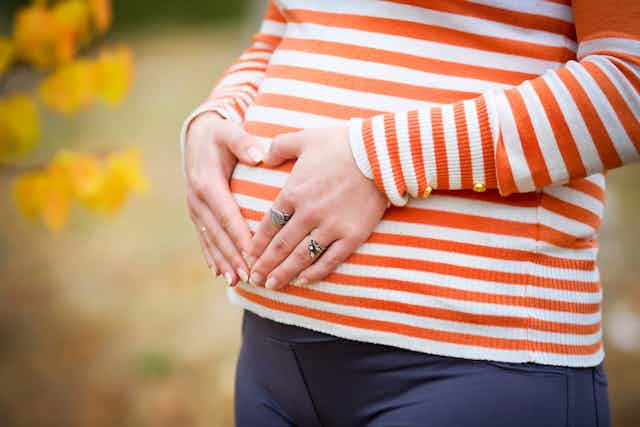While the old adage about having “childbearing hips”, is not usually a compliment, many women consider it an advantage when it comes to childbirth.
As midwives, we are used to allaying the concerns of petite women who are worried that their hips, or their bodies, are too small to give birth normally. They say things like, “my partner is so tall, look at the size of his head, what if my baby has his head?”
The excitement over the birth of the Prince George of Cambridge in July again brought to the fore concerns about women’s size and ability to give birth normally. No-one could suggest that the Duchess of Cambridge has “childbearing hips”. But she managed to give birth naturally to a baby who weighed a very healthy 3.8 kilograms.
Not all babies are getting bigger
Since 1998, there has been only a small increase in birthweight of babies born in Australia. One recent study reported median birthweight increased by 0 to 25 grams for boys and 5 to 45g for girls over the past ten years. This is likely due to an increase in maternal age, reduction in women smoking during pregnancy, excess weight and obesity among mothers, as well as Australia’s changing ethnic profile.
More importantly, there has been an increase in both very small and very large babies. During the mother’s pregnancy, these babies are more likely to need close clinical observation, which could lead to medical intervention such as an earlier birth if the baby does not continue to grow or thrive in utero.
Overall, the available data in Australia shows the majority of babies are in the normal growth range (about 2.8kg to 4.2 kg depending on gender and gestation), and the size of a baby does not seem to interfere with women’s ability to give birth.
Women’s pelvises are smaller in relation to the size of a human baby’s brain than most primates. This means that during birth, the baby rotates as it transverses his or her mother’s pelvis in order to fit. Ligaments in the pelvis soften in preparation for the birth, while the unfused fetal skull bones will mould over each other to enable the baby to adapt as it negotiates the birth canal.
The mechanisms of labour enable a baby to progress through the birth canal without obstruction. When women choose an upright position for birth without an epidural, gravity also helps the baby descend, resulting in a a shorter labour.

Evolution and the childbirth challenge
Evolutionary biologists have come up with an explanation of the possible challenges of childbirth. The “obstetrical dilemma” hypothesis suggests that the evolution of humans to walk upright on two legs resulted in a narrowing of the birth canal. With infant brains comparatively large, childbirth becomes problematic.
In evolutionary terms, this suggests that the female pelvis cannot expand further because this would interfere with the human capacity for movement. The obstetrical dilemma hypothesises that it is the constraint of pelvic size that determines the end of pregnancy and the timing of spontaneous labour.
A recent study has discounted the obstetric dilemma, suggesting instead that the spontaneous onset of labour is determined by the balance between maternal and fetal metabolism. This is known as the energetics of gestation and growth (EGG hypothesis), and suggests that labour begins when fetal energy demands surpass the mother’s ability to meet those demands.
This alternative theory states that as the baby grows through the pregnancy, so do the metabolic requirements for tissue growth and maintenance. By about 40 weeks, the metabolic demands of the baby start to push the woman’s energy requirements beyond what is easily possible.
Extending the pregnancy by even one month would likely require metabolic investment beyond the mother’s capacity. So instead, the mother goes into labour.
While there is still debate about the evolutionary principles that determine the size of newborn babies, the proposed EGG hypothesis helps us understand the importance of starting pregnancy as strongly as possible, with a healthy weight and good nutrition.

Healthy weight
A woman’s metabolism is essential in determining fetal growth, as well as support for labour and birth. Starting pregnancy in the healthiest state and ensuring appropriate weight gain means she is more likely to start labour at the right time and deliver a baby who is a healthy weight.
There are a number of risks for women who start pregnancy with a low or high pre-pregnancy body mass index (BMI), including preterm birth, small- or large-for-gestational-age babies, stillbirth, neural tube defects, gestational hypertension, postpartum weight retention and major depressive disorders. Women with a high BMI are also more likely to have their labour induced or to deliver by caesarean section.
It’s important to remember that most women are perfectly designed to grow a baby that is the right size for them and give birth. As midwives, we have attended many small women who have given birth to normal or large-sized babies. Equally, we have also assisted larger women who have had difficulties giving birth to small babies.
Giving birth is never as black and white as saying small women can’t give birth to large babies. Negotiating and understanding the grey zones and supporting women in either situation is key to the provision of safe and effective maternity care. It is the role of the midwife to give women the confidence in themselves and their bodies to grow and give birth in the best way possible for them.

